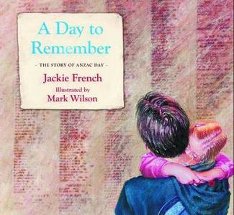A day to remember by Jackie French

Ill. by Mark Wilson. HarperCollins, 2012. ISBN 9780 7322 9360 4.
(All ages) Warmly recommended. War. Picture book. In showing
us the history of Anzac Day, Jackie French is also promoting a plea
for peace as the Australian Defence Forces concentrate more on
keeping the peace in countries, both near neighbours and those far
away. From the first Anzac Day, April 25, 1915, when thousands of
Australian and New Zealand troops were landed at Gallipoli in a vain
attempt to reach Constantinople, the day has been recognised as a
day to remember the valiant deeds of those brave few. Over the
years, Anzac Day has come to include all the men and women of all
the forces, and Jackie French gives us a deft potted history of just
how that day has developed. Through spare prose she tells us of the
few who gathered around the Cenotaph in Sydney in 1927,
leading to a few more the following year, building up to a Dawn
Service and a march. For some years the tradition faltered, as
attitudes to our involvement in war changed, but a resurgence of
interest and in particular, a rethinking of the sacrifice made by
these people, has served to reinvigorate the day's observance.
Today many make a pilgrimage to Gallipoli, many thousands make the
day a special day in their family's year, and many more watch the
march on television.
Mark Wilson has effectively used photographs and illustrations from
the past to render his impressions of our involvement in war for the
younger reader. Letters, newspaper accounts, old photographs,
pictures, medals and the occasional sprig of rosemary along with the
odd poppy, are drawn with pen and ink, and acrylic paint to produce
the sweeping illustrations of war and its aftermath. Each page
is markedly different as time flows on, the placement of the script,
the pictures, and scope of what we are seeing, all give a resonance
to the subject at hand, and impel the reader to look more closely at
the images presented An astute teacher or librarian would invite the
art teacher to discuss with the students the varying styles of work
Mark Wilson presents, and ponder the reasons for his using such
markedly different techniques.
I always marvel at the depth of research undertaken by Jackie French
in her historical books, and this is another which underlines her
considerable skill. I love the snippets of information she includes,
giving the sometimes known information something extra to ponder and
discuss.
Fran Knight